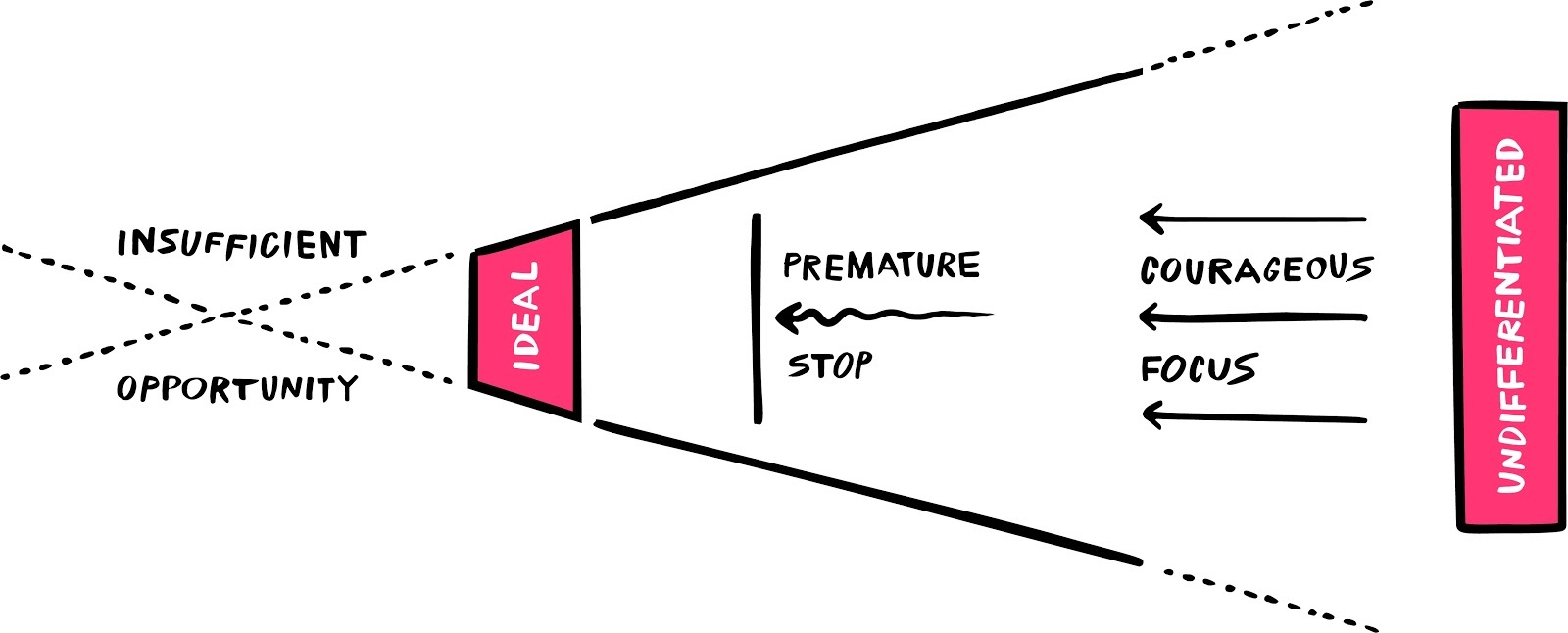The Counterintuitive Tactic: Increases Deal Size, Profits, Close Rates
Published: December 18, 2018Updated: December 20, 2024

Is your company laser-focused on a profitable target market? Or do you throw out as many lead gen darts as possible and sell to whatever sticks, even if it’s nowhere near the bull’s-eye? You can regain control. By sharpening your focus on who you serve and how you help them, you can set your business up for bigger success—selling your most profitable offerings to your dream clients.
As business owners or salespeople, we’ve all been there. The prospect is asking for a feature, service, or customization that we can’t accommodate.
We feel the opportunity slipping away. “If we just had that one extra service!” you think, “We’d close so many more sales!”
This is the trap I’ve seen countless businesses fall into—and one I’ve been a victim of myself.
At first glance, it makes sense. If people are asking for this “thing”, we should sell it!
More sales = more growth! Right?

The truth is, for most businesses, it’s not that simple. Actually, I’ve seen this trap stall out and kill more businesses than you can imagine.
The “Yes” Trap
So, what exactly is the trap?
Well, it’s trying to be everything to everyone. Simply put, it’s broadening your company’s offering too early and ending up with a positioning, sales, and operations nightmare.
As startup coach Dan Martell says, “Startups don’t typically die from starvation, they usually die from indigestion.” In other words, it’s not a lack of opportunity, it’s taking on too many things at once that kills new businesses.
Now you might be thinking, “I’m not a startup! Our company does $1 million, $10 million, or even $100 million in sales!” But, according to management consulting firm McKinsey, most companies aren’t ready (or equipped) to seriously broaden their target market and offering until post-IPO.
Falling into the “yes” trap is especially common in organizations that had a long stretch of growth driven by referrals. The real issue with referral growth is that it’s fleeting and inconsistent.
Soon a company can find itself with overhead to pay, and no predictable way to create pipeline. That’s how they end up saying yes to anything and everything that will bring in revenue, just so they can keep mouths fed and lights on.
It’s a quick road to becoming a jack-of-all-trades-master-of-none company that starts doing outreach out of desperation, and then can’t figure out why nobody will respond to their cold emails.
If you’re reading this, then chances are you either already have, or are in the process of taking back control of your company’s growth and revenue by creating a sales and prospecting process.
So what can you do to make that process more effective and make your business way easier to run at the same time?
Start saying yes to saying no
Saying yes can get you deals in the short term, and when you’re desperate and your pipeline is dry, sometimes that’s what you have to do.
But, to maximize sales velocity and profitability, often the counterintuitive yet effective thing to do is say “NO.”

Of course, the trick here is having enough pipeline to do that with confidence. The good news is learning to be more specific about who you serve and how you help them is the first step in creating that kind of a pipeline.
The fastest growing companies we’ve worked with do this extremely well. They position themselves as the authority at solving a specific problem for a specific type of buyer. This makes finding, selling to, and servicing clients significantly easier as they scale up their sales and marketing efforts.
As B2B sales strategist Larry Myler says, “All things being equal, the supplier/vendor holding the most inside knowledge wins [...] When business cases are on target, your chances of winning over a prospect increase significantly.”
It’s not just about making more sales
On top of making it easier and faster to acquire leads and close clients, there are other benefits to solving fewer problems for fewer people.
- You can often justify a higher price point than your competitors, since you’re positioning yourself as one of the few experts on that specific problem and vertical.
- You can often streamline your product or service, making it more efficient and cost effective. This increases the value you deliver to clients, while maximizing profits and efficiency in the business.
- Hiring, training, and onboarding new staff can be streamlined as your company acquires more knowledge and expertise in that specific vertical and problem space.
- It’s easier to create targeted content and become a standout in your niche.
Are you convinced yet? Let’s talk about how you actually realize all these magical benefits.
5 steps to sharpen your positioning and product
So, how do you practically go about figuring out where to focus your business? Here are a few pointers to get started:
1. Identify the most profitable problems you solve
Do an assessment of the different problems your business is solving. If you’re a service business, look at your last few contracts or projects and see how your revenue versus your time and materials played out.
If you’re a product company, take a look at what clients are buying more of more often or which clients are staying with you longer, and what “job” they’re hiring your product to do. What problem does it solve for their business?
Higher profitability is generally an indication of the fact that:
- The problem is important enough to justify a sustainable pricepoint.
- Your firm has, or could have, a repeatable process or product that can efficiently deliver value to the client with good margins.
2. Identify the most profitable client you can solve that problem for
Value is relative. Two companies with the same problem can have drastically different ideas about how valuable a solution is.
Think about it: a lead is way more valuable to a company with a $300,000 average contract value than to a company with a $3000 ACV.
A great example of this is Mediagistics, an advertising and marketing agency. They’re the self-proclaimed “#1 Agency for HVAC companies”.
At first glance, this seems like a small niche. If they’re so good at lead generation, why only do it for HVAC companies? Why not do it for everyone else?
Well, did you know that a commercial HVAC contract can be worth hundreds of thousands of dollars?
This company has clearly found a way to become an authority for a niche that can pay them high fees for their marketing service. On top of that, I’m willing to bet the entire lead gen process (including copy, images, segmentation, and targeting) doesn’t vary much from client to client, so they can create efficiencies in their process.
Are they the best marketing agency on the planet? Who knows. A better question would be, are they the best marketing agency in their niche? Based on the fact that they have over 100 employees, it wouldn’t surprise me if they win A LOT of business over other agencies because of their razor-sharp positioning.
3. Assess the size of the market and opportunity

According to entrepreneurial advisor David C. Baker, the ideal number of competitors for a consultancy is between 2 and 200, and the ideal number of prospects between 2,000 and 10,000.
Of course, these numbers are highly contingent on context and price point, deal size, industry and so on, but you get the idea.
If you’re a B2B company, the problem space and niche target you chose to go after should be a small enough pond that you can quickly become an authority, and make prospects feel as though you’re better suited to solve their specific needs.
Get a sense of how big the space is, what kind of price points you can charge, and what you need to do to win deals against the current competitors in that space.
A quick litmus test you can do for this on LinkedIn Sales Navigator: see if you can build a list of around 5,000 to 10,000 leads that have a really strong ACV. If you can, chances are that’s a good niche. If you can’t, it might be a bit too small to support your growth.
Assessing the market and opportunity well is how you’ll create a product or offering that feels bespoke and custom and commands that kind of a price point without actually having to do a lot of bespoke or custom work.
As you start to dominate a space, there’s a good chance you’ll have the infrastructure to support crossing the chasm into another similarly sized market. There, you can solve a similar problem, but for a slightly different vertical.
4. Run a test
Reach out to your existing clients. Learn about the language they use to describe the problems you solved for them and how the outcome has benefited them.
Then, use that learning to run a test in your market.
Build a list of 100 prospects in a very specific niche, with a very specific problem, and try reaching out to them with highly specified offers and case studies. See what the response is, and learn as much as you can about their buying criteria, challenges, and expectations.
If you’re really good at Facebook ads, you could also try running ads to a landing page for that specific offer to see how it converts.
Whatever you do, by the end of this test you should have a pretty good idea of whether or not that new position will be able to generate predictable revenue for your business.
5. Position your brand
If the test goes well and you decide to refine your positioning, it’s time to let people know exactly who you serve and how you serve them by repositioning your brand.
I find lots of businesses, especially in the service space, have trouble with this. Most of it comes back to their FOMO—fear of missing out. “What if a client decides not to work with us because our positioning is too narrow?”

The reality is, word of mouth is still going to be a thing, even if you’re explicit about your perfect client.
You’ll still get referrals, just like you always have. The difference is, if you’re doing this well, you’ll have enough highly qualified leads that are a perfect fit for what you do that you won’t feel compelled to say yes to those inbound leads at the cost of your profitability and efficiency.
Change your website, social media, and other assets to reflect your newly focussed position. These days, people are hitting up your website, social media, and content to vet you throughout the sales process.
You can’t just change your outreach. For example, most of the people that reply to my cold emails also click the link to our website in my email signature. If the language on my site doesn’t match up with the pitch in my email, it’s a bad sign to them.
The more your marketing channels reinforce that you’re an expert for a prospect’s specific space, the more likely they are to trust and engage with you.
A great framework to use here to is a variation of the seven-word intro:
We help X (Target Buyer) do Y (Desired Outcome) by Z (Specific Solution).
For example—We help HVAC companies with $10M-50M in revenue acquire high-value clients through PPC ads.
In Closing
If you leave this post with one thing, let it be the desire to take a closer look at your client base and the work you’ve done. You may find gold mines you’ve been standing on this whole time.
Often in sales, less is more. When it comes to creating pipeline, precision penetrates. The more clarity you can create for your prospects around who you serve, and how you serve them, the easier it is for them to identify themselves as a good fit.
So don’t be afraid to take a look at your business, identify your dream clients, and ask yourself, “What would it be like if we only worked with clients like that?”
Because in the words of Parks and Rec’s Andy Dwyer (aka Burt Macklin, aka Johnny Karate):



